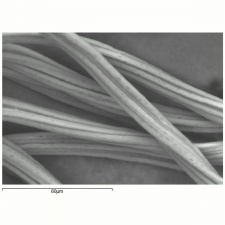In my last article about surfaces, I gave you an overview about natural fibers, why some of them can be itchy and how they are structured. I chose the position of “pro natural fibers” to explain you, why they are my favorites for most of my clothes.
In this article, I hold the opinion “pro synthetic fibers”. While natural products have a many good properties as for example heating and cooling capabilities at once, in special cases, they are not even close to the capabilities of synthetic fabrics.
General Synthetics
Not all man-made fibers are fully synthetic, but most are. Usually they are produced out of petrochemicals and other non-natural materials. Of course, we can discuss how chemicals are to differentiate. Here I would say non-natural means non-renewable resources.
There are many different synthetic fibers for example, metal (steel or silber yarn), ceramics (silicon oxide or carbide), carbon and the important polymer fibers. In this article, I will concentrate on the group of polymer fibers, because they are an important textile fabric and you can find them in most of today’s active and functional wear.
Polyester (mostly PET), Polyamid (Nylon) and Spandex (Elastan, Lycra, Polyurethan) are the fabrics I am most interested in, because you find them everywhere when it comes to clothing (e.g. jeans, suit, pullover and so on).
I won’t go through the detailed processing of the fibers. The focus will be on the properties as a fabric to compare it with natural and semi-synthetic fabrics.
Polyester is „the“ synthetic fiber. It is resistant against tear and wear. It doesn’t absorb humidity so dries very fast. Fibers thickness nowadays is less than 12 µm and this is usually thinner than every natural fiber used in fabrics. [1,4,8]
Nylon, the historically first fully synthesized fiber. I think the most famous connection to fashion are stockings. It is highly elastic, resistant against temperature variations and fabrics with it crinkle less. [2,4,8]
Spandex is for me as a heavy metal fan a very questionable fabric… but okay, the hairstyle was as well, you may understand… Today Spandex is mainly used in mixed fabrics and usually less than 10%. Especially mixed with cotton it creates the „stretch effect“. As a stand-alone, this Polyurethane-based fiber is like rubber and can stretch up to 700%. Just by the way it is easy to dye.[3,4,8]
Natural synthetic fibers
Now I’ll tell you something strange, but from a biomimicry perspective, it is very interesting. There are several fibers, which are processed like synthetic fibers, but are based on natural resources like proteins or cellulose.
My personal favourite is Modal followed by Viscose, both are based on cellulose, which is the reason why you can find this article under our wood theme session. The raw material is cellulose from wood, mainly beech, spruce, pine, eucalyptus, bamboo and other kinds.
Do you remember the mercerization process of cotton from my last article? It is a refinement procedure where tense cotton yarn is pulled through a sodium hydroxide solution to increase the cotton’s properties. Cellulose undergoes the same procedure during the process, but for other reasons.
Here is a small video and picture of the production process in a lab.
In Europe Modal is created only out of beech. The process is nearly the same as the Viscose process with the main difference during the spinning process, which causes some very interesting yarn/fabric properties. Maybe someone of you can figure out what exactly is the difference. The producers don’t write anything about it. [4,5,6,7,8]
Properties
Viscose, also known as Rayon or artificial silk, is a shiny, light and soft textile. I think that the name artificial silk is a good choice to describe the feeling of wear, but is very bad to describe the behavior of it. For example, silk creases rarely, while Viscose is the exact opposite. Furthermore, silk is at least a little bit stretchable. The biggest advantage is that it can absorb 400% water in relation to its weight. Consequently, it is also a cooling fabric. [5]
All these characteristics make Viscose perfect for lining, like in your suit and trousers.
Now to my personal favorite Modal. It is in my opinion the most developed synthetic fiber today. It rarely creases, absorbs water like Viscose but dries very fast, due to its structured surface. The fiber is resistant against tear and wear like polyester. It is a bit stretchable, similarly to silk.

http://cameo.mfa.org/wiki/Modal_fiber
Both materials have also some disadvantages, which are shared with the other synthetic fibers. They smell… and in the case of Viscose and Modal, they have no warming capabilities!
Natural vs. Synthetic
Here we are, reading about the characteristics of some very widely used synthetic fibers and you maybe are reminded of some natural fibers. In this last part of the article I would like to show you the main difference between these two worlds, but only from a point of view based on the material properties.
We could also discuss the moral issues of natural fabrics against synthetic ones, but this is a little too far away from Biomimetics and Biomimicry, which is clearly connected to synthetic fabrics.*
Natural fibers are multipurpose materials and with multiple I don’t mean one or two properties. Wool keeps you warm, also cool. It is hygienic and doesn’t smell (bacteria). It absorbs, evaporates and conducts water. It also keeps you warm when its wet. Therefore, it clearly is a material appropriate for different situations, just depending on how it was processed during cloth manufacture.
Synthetic fibers are special. Polyester can be produced finer than every natural fiber and a textile can be created which can warm you, but you will sweat, because it cannot absorb water. But it will cool you if you sweat a lot. It is the perfect example for functional wear. You don’t want it in winter, because if you sweat, then you are freezing (and smelling). If you are a lonely long distance runner or jogger, you like to wear it every time, because this very fine fabrics create a very high capillary effect. The water „runs through“ the textile and quickly evaporates, which is impossible in any other natural fabric.
For daily use I found trousers, which I really like and they are synthetic. They have warming and cooling capabilities like wool. The textile fabrics is rough which excludes it as a shirt or pullover material. It is a mix of 1/3 polyester and 1/3 viscose with a bit spandex. The big trick here is, that the manufacturer added ceramic particles to the yarn. Consequently, it stretches, regulates temperature via viscose and the ceramic particles and gives UV protection, also because of the ceramic particles.

grey trousers, textile mix with ceramic particles (2/3 polyester, 1/3 viscose + spandex), click to enlarge
The time is over, where natural fibers were the one and only thing, where polyester shirts felt like plastic bags with sleeves. Now we have functional wear which fits the activities we perform. If we are combining different synthetic fibers, we can try to develop something which is doing multiple things. But until today, I didn’t find a pullover out of synthetic fibers that I could wear and feel cozy. I can wait, in some years, maybe I find something. Today, I just won’t miss my cotton/modal mixed shirts, they are the best I have ever had.
*During the lecturing, I got the question “What are the moral issues of natural fibers?” So maybe I should write something. The first thing, where I chose synthetic over natural source was the shaving brush. Usually the brush is equipped with american badger hair (also known as silver tip). Now take a look where most of the hairs come from: large-scaled factory farming. Of course, this is an issue also for chicken, pigs and so on. There are also rough methods of farming other animal’s hair. Remember the angora rabbit, where the hair was not shaved, but pulled out of the living animal! There is also the mulesing of merino sheep. In addition to that, most of the cotton production is a problem, too. If you don’t buy specific fabrics, you most likely buy stuff, which was produced unsustainable. So please, just take a look about what you buy! A well-known name doesn’t matter here. In my experience, I get the best quality from small or very specialized labels, which are show you exactly how they produce and where they buy. These products are not cheap, but not more expensive than well-known labels. For further questions, you can contact me via e-mail.
References
*Most descriptions are based on my own experience and of course the following sources.
[1] Rosato, Dominick V.; Rosato, Donald V.; Rosato, Matthew V. (2004). Plastic product material and process selection handbook. Elsevier. p. 85.
[2] https://en.wikipedia.org/wiki/Nylon
[3] http://www.madehow.com/Volume-4/Spandex.html
[4] http://onlinelibrary.wiley.com/doi/10.1002/0471440264.pst251/abstract
[5] http://cameo.mfa.org/wiki/Modal_fiber
[7] http://www.lenzing.com/en/fibers/viscose-and-modal-fiber-production.html
[8] https://en.wikipedia.org/wiki/Fiber
[9] https://web.archive.org/web/20080406101953/http://www.afma.org/f-tutor/rayon.htm







Hi Jan,
Thanks for the article. Have you considered looking up the health effects of the various synthetic and natural synthetic fibers used in clothing (and furniture, too) today?
Hi Polly,
Health effects… Hmm. I’m not sure how to look at this topic. There could be passive and active parts that influence your actual health. I would not say that a specific natural fabric is more healthy than a synthetic fabric independent of their actual use.
(Like horse hair for layered beds etc.)
I consider your question in try to find time to maker further investigations.
kind regards,
Jan